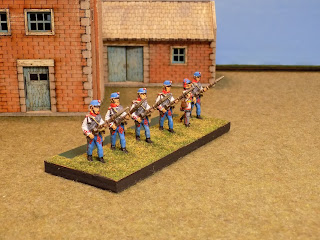 |
| The Usual Supects... |
Last Friday was the February game night for my gaming club, The Northern Conspiracy
This is my report. For those with strong stomachs, you may clix pix for BIG PIX...
Above left, Robert, our current leader, engages in a fruitless attempt to organize the Penguins (always a good occasion for a gesture or two...). Charlie, in the handsome ski sweater to El Presidente's left, was handing out complimentary copies of his Napoleon's Rules of War Napoleonic miniatures rules that he had just published on Amazon (these had been in development with the club for several years). Above Right, in the baseball cap, fellow blogger Mark, of Mark D's Gaming Site, provides some adult supervision. Meanwhile, Kevin, recently relocated to these parts through the Federal Witness Protection Program, ducks the camera. Never fear, Kevin. Your secret is safe with us, Kevin!
As usual there were three games on tap for the evening's pleasure...
Fellow blogger AJ, of AJ's Wargaming Blog , ran an Iron Cross WWII game. You can find a more complete run-down of his game at his blog (also another report on the game night).
 |
| AJ explaining the rules. |
 |
| AJ's amazing scratch-built radar site for the game. |
A sampling of AJ's 15mm WWII figures in action.
For game #2, Phil hosted another WWII game, only this one was early war (French vs German armor).
 |
| Phil setting up--as seen from the next table over. |
Some of Phil's Early War French Armor
Unfortunately, I didn't follow much of what went on at these other tables, because I wound up playing in game #3--Ralph's 28mm American Civil War game using his (some day to be published) Steady Boys ACW rules. (Aside: Ralph has also published a set rules: for ancients Hannibal at the Gates). Unfortunately, I didn't get a shot of Ralph, but what follows is my Battle Report on the game...
 |
| Ralph's Amazing 28mm ACW Figures. |
Ralph always puts on a beautiful table. This game featured a train (too cool for school!) and a very detailed station. Eye-candy though they were, they also provided the stuff of the scenario. It seems that we (the Union) had captured a key railhead, the loss of which had seriously compromised the Secessionist position in the region. Thus, the Confederates (Earl and Rob) came to the table with two big divisions plus a cavalry brigade to wrest said station from two smaller (heroic) Union Divisions, commanded by yours truly (the Meanderer himself) and Charlie.
 |
| The Confederate deployment: a solid wall of Gray! |
It was our task to hold the station and also see if we could run the train off of the table (exit at the top of picture--not bloody likely!). Additionally, both sides had a break point, so beating up the enemy would be a means to victory as well. The Union took positions down the line, with Charlie's division to the left and my division on the right. Both Union Divisions were of equal size, so we weighted the effort on the left a bit by giving Charlie's division a shorter sector. On the other side of the table, the Secessionists massed on the right, with General Beauregard Earl on the right and Oilcan Rob on the left. The Confederate main effort would clearly be a turning motion from their right.
At this point, dear reader, I shall ask your indulgence as I relate the action on the Union Right, where I was heavily involved, and then the action on the Union Left, which will necessarily be of a more brief nature given my personal circumstances.
First, dear readers, my plan for the Union Right...
 |
| ...was to sit on the hills and shoot whatever came my way... |
 |
| ...sheer genius! How do I come up with these cunning strategems? |
 |
| My bully Hoosiers waiting for trouble at the end of my line. It wouldn't be long in coming! |
Rob launches his division across the table...
 |
| The Gray Wave Rolls Closer... |
 |
| ...And Closer... |
 |
| ...And Closer, Until... |
 |
| ...Close Enough! |
 |
| This Day, General Dice was serving on attachment with the Union Right, and the shootin' dice were rolling hot for my Boys in Blue (thankfully). |
|
|
 |
| The smoke cleared to find the Secessionists swept from the Union Right. |
Meanwhile, on the Confederate Right...
 |
| The massed Confederate Right Wing moves out... |
 |
| General "Shaka" Earl's Impis of the Confederate Right Horn head for Charlie's command, the drumming of their assegais on shields filling the air. The call for ammunition was the last that was heard from the brigade at the end of the Union line there. |
We had pounded the Confederate left to smithereens, but had taken our lumps in the center and left/center. Both armies were right at their breaking points...
 |
| ...But then Rob launched two key assaults that broke two of our units in the left/center and the Union cracked first! Oh, the humanity! |
Well played and a good time was had by all! Thanks to Ralph for the excellent game and to Charlie for standing up to the beating we took in his sector--and to our honorable opponents for the evening: Earl and Rob.

























































